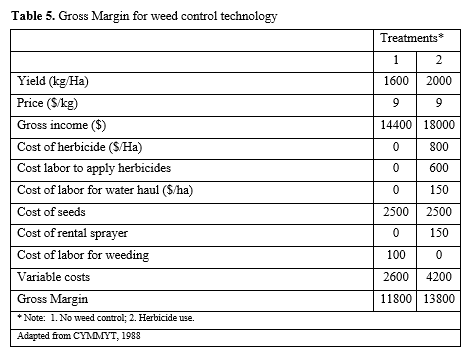You are here
Gross Margin
Gross margin analysis is an alternative technique that can be used to calculate the profitability of technology. The measure focuses on variable costs and ignores the fixed or overhead costs since fixed costs will be incurred irrespective of the technology or level undertaken (Rural Solutions, 2012). Farmers do make decisions on what kind of technology may be economically efficient and technically feasible. Gross margin indicator may help in assessing technologies being developed for potential dissemination by comparing their benefits with conventional technologies . By focusing on the variable costs , the indicator is not data-intensive and may be simpler to compute than net income. Gross margin of the farm can also be calculated by summing up the gross margins on field activities.
How to operationalize the metric
Method of data collection and data needed to compute the method:
To calculate gross margin, the researcher must be aware of the objective of the farmer or the project and secondly account for the factors that will change and which ones will remain the same with the new technology. In this way, data on the costs that may vary in the production process are captured for analysis. Once these two aspects are considered, then data should be collected. There is no generic list on the variable costs but for the gross incomes, data on the price of output (crops or livestock products and by products) plus the total production on the farm should be collected. This data is used to calculate the value of the field or farm products (Gross Income). Data on variable costs should be collected and this may include; labor costs, feed costs, cost or pesticide or herbicides, cost of animal medicine, transportation costs, cost of seeds (germplasm) e.t.c. There costs should be considered in terms of the new technology. This data may be collected using a survey that has been adapted for the technology. In cases of field experiments, journal entries should be done for the inputs costs and output. Price of the output can be obtained by performing a market survey on the price of the commodity. It should be important to note that for field experiments, there is a difference between market cost and the “field price” (CIMMYT, 1988). In some cases, the market price may differ from the price that farmer receives because the product may be bought at the farm gate. In addition, there is seasonality of price, which may differ at the time of harvest and before harvest. These should be taken into consideration when assessing the price of the output.
Unit of analysis:
Gross margin is calculated as: ![]()
At the farm or household level where there are multiple activities then total gross margins is calculated as
 where i is the activity on the farm (crop production, poultry production, ruminant production, e.t.c. (Amir and Knipscheer, 1989). Gross margin has an advantage in that is can be used to simply rank technologies with a focusing on their profitability. For illustration, suppose there is a new technology of herbicides that is going to be tested on fields that use two different seeding rates to examine which one may provide higher benefits. The table below provides that illustration.
where i is the activity on the farm (crop production, poultry production, ruminant production, e.t.c. (Amir and Knipscheer, 1989). Gross margin has an advantage in that is can be used to simply rank technologies with a focusing on their profitability. For illustration, suppose there is a new technology of herbicides that is going to be tested on fields that use two different seeding rates to examine which one may provide higher benefits. The table below provides that illustration.
From the example above, treatment 2 may be chosen because it has a higher gross margin. But to complement this analysis, the researcher may also consider examining the breakeven price and breakeven output of the two technologies (Amir and Knipscheer, 1989). Gross margin of technologies that have different fixed costs should not be compared. It is important to also note that an intervention that has the highest gross margin may be more sensitive to price (input or ouput price) variation. This risk may be calculated by comparing gross margin with different prices (Rural Solutions, 2012).
Limitations regarding estimating and interpreting:
Gross margin should be interpreted with caution since it may not consider the fixed or overhead cost of production. Therefore, inferring that farm profits may be increased by scaling up production may not be realistic (Amir and Knipscheer, 1090; Dillon and Hardaker, 1993). In cases where data collected is done at experimental fields at the station, production values may over estimate what farmers may produce on their actual fields. Gross margin should be complemented with additional analysis such as break even analysis. This may provide information on breakeven price; the level at which the gains equal the costs.


